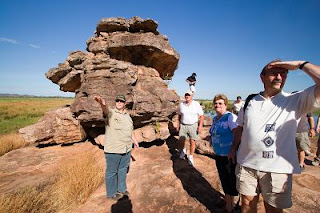 OK here's a portrait shot taken with a wide angle lens. Or is it a landscape shot with a person in it? Most likely the latter. You can see what I mean about how small everything is if you don't get nice and close?
OK here's a portrait shot taken with a wide angle lens. Or is it a landscape shot with a person in it? Most likely the latter. You can see what I mean about how small everything is if you don't get nice and close?Compared to yesterday's shot where I was up close and personal with my subjects, and so the people are quite large and prominent in the frame, here my wife has been reduced to a speck.
But the wide angle lens does what it's supposed to. It shows the space between objects. The lake looks a lot bigger than it really is. I mean it's quite large but if you look at the tiny little village on the other side (middle LHS of the frame) you would think it was a couple of kilometres across whereas it's probably 4 or 500 metres or so.
The mountains themselves look reasonably big but they're certainly not the dominant features in the picture that they are in real life. The reason? They're the farthest thing away from the camera. And the little puddle at my feet looks like a large lake because it's the closest thing to the camera.
OK, well it's all fine and dandy to talk about how a wide angle lens does this and it does that, but what would happen if you shot this picture with a telephoto lens?
SHAZAM!
 As you can see it's not longer an environmental portrait. Well there is some environment there but it's mostly just a big rock face - the side of Gokyo Peak .
As you can see it's not longer an environmental portrait. Well there is some environment there but it's mostly just a big rock face - the side of Gokyo Peak .Now the angle I shot this from is slightly different from the above picture. I've moved slightly to the right to frame my wife in front of the mountain (which is to camera left in the wide angle shot)
But you can see what I mean about the focal length having such a vivid effect on your images. Same relative position between camera and subject, could have been taken in a completely different place for all that they are different.
As you can see, the telephoto has a very narrow point of view. You can't really see much around my wife at all (handy if your subject is surrounded by rubbish bins!). Another thing you'll notice is that the background looks very close - in actual fact it's about 300 metres away. This was taken with a 400mm lens on a tripod.
So if you want to make two objects look like they're a long way away from each other - go for the wide angle lens. Just don't forget that you're going to have to get up nice and close or else everything in the frame will be a speck. If you want to make two objects look really close to each other (even though they may be miles apart) the longer the telephoto the better. But the trade off is that you can't see much of anything around your subject because of the narrow field of view.
Next week I'll show you some more telephoto shots and how they are so different from the wide angle images. Then hopefully you'll have a pretty good idea which focal length lens to reach for to create the image in your mind.
Have a great weekend everybody.



